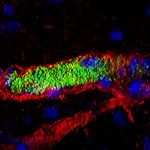Lien vers Pubmed [PMID] – 29282282
Lien DOI – 10.1091/mbc.E17-04-0231
Mol Biol Cell 2018 02; 29(4): 380-388
The shaping of a multicellular body and repair of adult tissues require fine–tuning of cell adhesion, cell mechanics, and intercellular transmission of mechanical load. Adherens junctions (AJs) are the major intercellular junctions by which cells sense and exert mechanical force on each other. However, how AJs adapt to mechanical stress and how this adaptation contributes to cell-cell cohesion and eventually to tissue-scale dynamics and mechanics remains largely unknown. Here, by analyzing the tension-dependent recruitment of vinculin, α-catenin, and F-actin as a function of stiffness, as well as the dynamics of GFP-tagged wild-type and mutated α-catenins, altered for their binding capability to vinculin, we demonstrate that the force-dependent binding of vinculin stabilizes α-catenin and is responsible for AJ adaptation to force. Challenging cadherin complexes mechanical coupling with magnetic tweezers, and cell-cell cohesion during collective cell movements, further highlight that tension-dependent adaptation of AJs regulates cell-cell contact dynamics and coordinated collective cell migration. Altogether, these data demonstrate that the force-dependent α-catenin/vinculin interaction, manipulated here by mutagenesis and mechanical control, is a core regulator of AJ mechanics and long-range cell-cell interactions.

